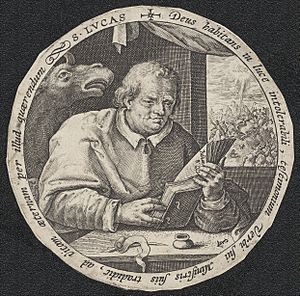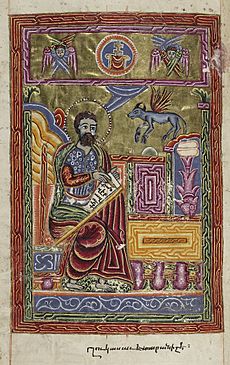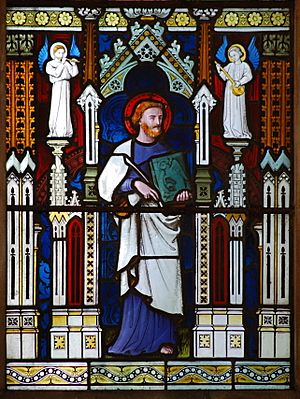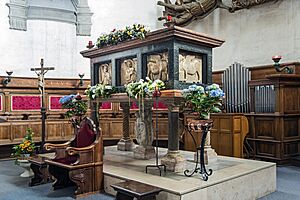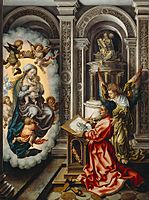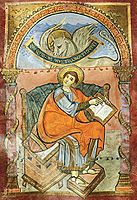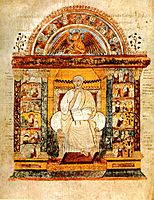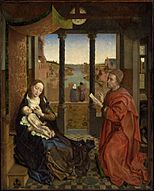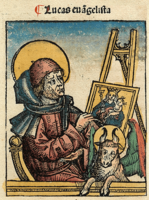Luke the Evangelist facts for kids
Quick facts for kids SaintLuke the Evangelist |
|
|---|---|

A painting of Saint Luke by Toros Roslin, an artist from the 1200s.
|
|
| Apostle, Evangelist, Martyr, and Doctor | |
| Born | Between 1 AD and 16 AD Antioch, Roman Syria (modern-day Antakya, Turkey) |
| Died | Between 84 AD and 100 AD (traditionally aged 84) Thebes, Boeotia, Roman Empire (modern-day Thebes, Greece) |
| Venerated in | Most Christian Churches that honor saints, and in the Druze faith |
| Major shrine | Padua, Italy |
| Feast | |
| Attributes | Evangelist, doctor, man with a book or pen, a winged ox or calf, painting an icon of the Blessed Virgin Mary |
| Patronage | Artists, notaries, bachelors, physicians, goldsmiths, butchers, brewers, glass workers, and others |
| Major works | Gospel of Luke, Acts of the Apostles |
|
Luke of Antioch
|
|
|---|---|
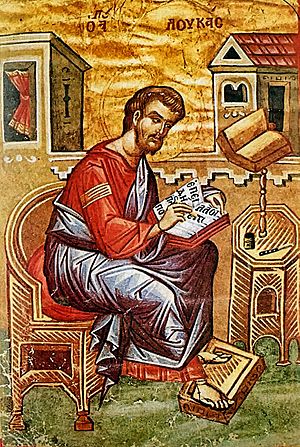 |
|
| Occupation | Christian missionary and Historian |
| Language | Koine Greek |
| Notable works | Gospel of Luke and Acts of the Apostles |
Luke the Evangelist was one of the Four Evangelists, the writers of the four main stories about the life of Jesus in the New Testament. He is known for writing the Gospel of Luke and the Acts of the Apostles. Early Christian leaders like Jerome and Eusebius agreed that he wrote these books.
The Bible mentions Luke a few times. In the Epistle to the Colossians, he is called a doctor. Because of this, people believe he was a physician and a close friend and follower of Saint Paul.
Christians consider Luke a saint. He is the patron saint of artists, doctors, surgeons, and many others. His special day, or feast day, is celebrated on October 18th.
Contents
Who Was Saint Luke?
Many experts believe Luke was a doctor from the ancient city of Antioch, which was in Roman Syria. He was likely born into a Greek family and was very well-educated. His writing in the Bible is in excellent Greek, which shows he had a good education, like someone who had read famous Greek writers like Homer and Plato.
Luke is mentioned by name three times in the New Testament. In his letters, Saint Paul calls Luke his "fellow worker" and "the beloved physician."
Traveling with Saint Paul
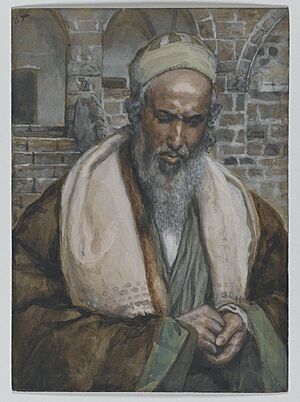
In the Acts of the Apostles, the writer sometimes uses the word "we" when talking about Saint Paul's travels. For example, he writes, "we sailed from Troas" or "when we came to Rome." Many people think this means the author, Luke, was actually there with Paul on these journeys.
Was Luke Jewish?
In one of his letters (Colossians 4:10-14), Paul sends greetings from his friends. He lists a few Jewish friends and then separately lists Luke. This has led many to believe that Luke was not Jewish, which would make him the only non-Jewish writer in the New Testament. However, others think he may have been a Hellenized Jew, meaning a Jewish person who grew up with Greek culture.
According to tradition, Luke lived a long life and died at the age of 84 in a city in Greece.
The Books Luke Wrote
The Gospel of Luke and the Acts of the Apostles were written as a two-part work. Today, we call this work Luke–Acts. Together, these two books make up more than a quarter (27.5%) of the entire New Testament. This is the largest contribution by any single author in the Bible.
Although the books don't name their author inside the text, the oldest known copies of the Gospel have Luke's name on them. From the earliest days of the Church, Christians have agreed that Saint Luke was the one who wrote them. The Gospel of Luke tells the story of Jesus's life, and Acts of the Apostles tells the story of how the Christian church began and spread.
Luke as a Historian
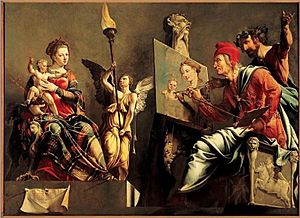
When Luke wrote his books, he did so in the style of the great historians of the ancient Greek world. In the first few lines of his Gospel, he says that he has carefully investigated everything to write an "orderly account" for his reader, Theophilus.
Many historians and archaeologists have been impressed by Luke's accuracy. He correctly described towns, islands, and the titles of Roman officials. This shows he paid close attention to detail.
However, some modern historians question parts of his writing. Because Luke's books describe miracles, like angels appearing or people being healed, some scholars find it hard to treat his work as a purely historical record. Luke's main goal was not just to record facts, but to teach people about his faith.
The First Christian Artist?
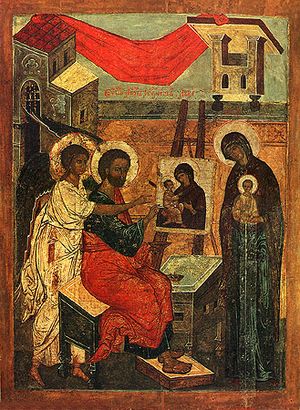
A very old Christian tradition says that Saint Luke was the first person to paint an icon (a holy painting). He is said to have painted pictures of Mary holding the baby Jesus.
Over the centuries, several famous paintings have been said to be the original ones painted by Luke. These include the Black Madonna of Częstochowa in Poland and Our Lady of Vladimir in Russia. Because of this tradition, Luke became the patron saint of artists. In the Middle Ages, painters in many European cities formed clubs called the Guilds of Saint Luke.
Saint Luke's Symbol: The Winged Ox
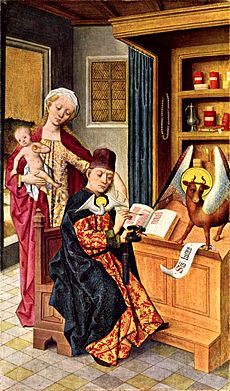
In art, each of the Four Evangelists has a special symbol. Saint Luke's symbol is a winged ox or bull.
This symbol was chosen because Luke's Gospel begins in the Temple with Zachariah, a priest who offered sacrifices. The ox was an animal commonly used for sacrifices in the Temple. The symbol reminds Christians of the importance of sacrifice in Jesus's life and ministry.
Remembering Saint Luke Today
Saint Luke is honored as a saint in many Christian churches, including the Catholic, Eastern Orthodox, and Anglican churches.
Feast Day
The main day for celebrating Saint Luke is October 18th.
His Relics
After Luke died, his remains, known as relics, were kept in Thebes, Greece. In the year 357, they were moved to Constantinople (modern-day Istanbul, Turkey). Later, they were moved again and ended up in Padua, Italy, where most of his body rests today in the Abbey of Santa Giustina.
In the 1990s, scientists were allowed to study the remains in Padua. They used modern techniques like carbon-14 dating and DNA testing. Their research showed that the bones belonged to a man who died between the years 72 AD and 416 AD and was of Syrian origin. This matches the ancient stories about who Saint Luke was.
Today, the relics of Saint Luke are in three places:
- His body is in Padua, Italy.
- His skull is in the St. Vitus Cathedral in Prague, Czech Republic.
- A rib was returned to his original tomb in Thebes, Greece.
Gallery
- Luke the Evangelist in art
See also
 In Spanish: Lucas el Evangelista para niños
In Spanish: Lucas el Evangelista para niños


